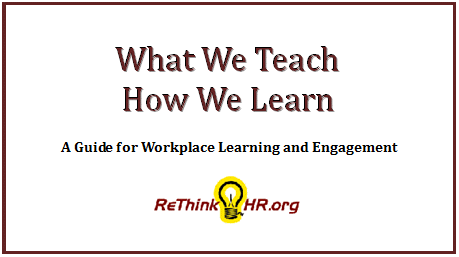I’m still on vacation - hope you all have enjoyed reading the guest post while I am soaking up the sun!! Today’s guest post c omes from Trish McFarlane. Trish is a writer, speaker, and HR pro that works as a practitioner in the trenches every day. She muses about her adventures at her blog - HRRingLeader.com. Subscribe! In this post, Trish discusses forms of training and understanding that people have different ways they learn. You can follow her on Twitter @TrishMcFarlane
For years though, it has been thought that any time an employee has an issue, if there is a situation that blows up, or if a skill is needed, it should involve being shipped off to a training course. I can’t tell you how many times I personally have written classroom-style, presentation sessions on topics ranging from how to interview to diversity and inclusion. Now, there’s nothing wrong in creating courses or sending employees to a class now and then. However, I am a believer that training in a classroom is often not the best first course of action for several reasons.
Adults have different learning styles-
-
- Presentation- This is the most traditional and the one that is probably used the most. It is purely a speaker at the front of the class, PowerPoint slide deck at the ready, who will talk AT you for an hour on a specific topic. Pros- familiar format, communicates a good deal of information in a short period of time, easy for the speaker to prepare for this type of training class. Cons- Easy for employees not to pay attention, doesn’t focus on individual needs, depending on group size can be very hard for the speaker to connect with the audience.
- Facilitated Discussion- This is like the presentation style, but better. It still has a focus and some specific points to cover, however, a skilled facilitator will bring the group together in such a way that the facilitator draws the information out of each participant. The group actually learn from each other.
- Case Study- These are great when you want to have teams think out of the box. Ask the group to try to “solve” a problem for a completely different group in the organization. The results may include ideas that won’t work in the budget or the time frame, but you just may get lucky and find a whole set of solutions you didn’t consider.
- Demonstration- This is my favorite of all the classroom style trainings. I believe that people learn best when they are hearing the speaker tell about the topic, WHILE they are watching the speaker do the task, WHILE they are attempting to follow along and do the task with the instructor. This gets three different parts of the mind moving at the same time and thus, produces better, longer retained learning.
- Role Playing- Most people do not like to participate in role playing, however, this is another great way to have someone learn. I find this especially helpful when coaching managers on how to handle difficult discussions. Having the opportunity to “try out” how those words will feel is often enough to give the manager confidence going in to that meeting with the employee who needs skill development or behavior modification.
- Individual Reading and Exercises- This is for the truly self motivated. The employee has to be the kind of person who can read a book, grasp important concepts, and put them into daily use. Easier said than done.
- Incorrect Diagnosis- By attempting to fix the situation or problem, you may be missing the actual cause of the skill deficiency, behavior, or action. Typically, if the HR pro or the manager digs deeper into the situation, the root cause can be determined. Once this is known, the appropriate next step can be taken.
- Employee isn’t ready to admit the problem- I can assure you that if you work in human resources for any length of time, you’ll run into this issue. Just because HR or a manager determines there is a problem….”Houston, we have a problem…”, does not mean that the employee agrees. Sometimes they like their behavior just the way it is. Sometimes, they don’t want to get promoted or learn that new skill or technology. Hey, don’t judge. If it’s a job requirement, you’ll have to deal with the fallout of the refusal to change or learn. Otherwise, you’ll waste their time and the department’s money sending them to a training class they will not embrace.
- It’s not geared toward the individual- This is the main reason I do not like classroom training. I tend to learn at one pace, typically fast. I like the presenter not to use too many slides, I like to get the facts, and get working with others to talk through some real life examples. It’s just what works for me. However, each person in that class probably learns differently (see the learning styles above) and if they received on the job training from an individual or multiple individuals, it would be specifically geared to that employee, his needs, and his pace.
Were there ever times in your career where a manager told you that YOU needed training to learn a skill or fix a behavior (come on, you know we’ve all been told that at least once)?
What type of training did they have you attend, or was it done on the job? Share with us in the comments. I’m betting you have some really good stories.


